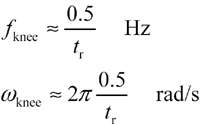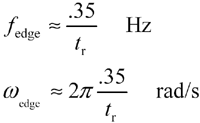Necessary Mathematics: Input Impedance and Transfer Function
Necessary Mathematics Input Impedance and Transfer Function
The performance of the linear, time-invariant transmission circuit shown in Figure 3.3 depends on four crucial factors: the characteristic impedance of the line Z C [3.15], the raw one-way propagation function of the transmission line H [3.14], the source impedance Z S , and the load impedance Z L . All four of these complex phasor quantities vary with frequency. Although the figure is drawn representing a single-ended coaxial configuration the same considerations apply to any form of conductive transmission circuit.
Figure 3.3. A transmission line complete with source and load impedances may be modeled as a cascade of three two-port circuits.

The input impedance v 2 / i 2 of a loaded transmission line is derived in Appendix C, "Two-Port Analysis."
Equation 3.16

The gain G of the circuit of Figure 3.3, taking into account all the relevant loading effects and end-to-end reflections, is (see Appendix C)
Equation 3.17

|
where |
G is the overall system gain from the open -circuited output of the driver v 1 to the load v 3 , |
|
Z S is the source impedance of the driver ( W ), |
|
|
Z L is the load impedance at the far end of the transmission structure ( W ), |
|
|
Z C is the characteristic impedance of the transmission structure ( W ), and |
|
|
H is the one-way propagation function of the raw, unloaded transmission structure [3.14]. |
Formulation [3.17] is most useful for analyzing the behavior of lumped-element and RC-mode transmission structures. An alternate form applies best for the analysis of the low-loss structures (LC, skin-effect, and dielectric-loss regions ).
Equation 3.18

|
where |
G is the overall system gain from the open-circuited output of the driver v 1 to the load v 3 , |
|
|
|
|
|
|
|
H is the one-way propagation function of the raw, unloaded transmission structure [3.14]. |
If your objective is the undistorted conveyance of a signal from source to load, then you must ensure that the propagation function [3.17 or 3.18] remains flat over the band of frequencies covering the bulk of the spectral content of your data signal. The requirement for "undistorted conveyance" is equivalent to asking that each transition arrive intact, at full size, without significant dispersion of the rising or falling edge, and without any lingering aftereffects, like reflections or ringing. Such a waveform is useful for first-incident-wave switching , meaning that the first edge arrives with sufficient fidelity to be immediately and reliably used.
On the other hand, if you are willing to wait a few round-trip times for your signal to settle , then you do not need your signals to arrive with first-incident-wave quality. You can in this case tolerate significant imperfections in the frequency response of your channel, all of which are cured by waiting for the steady-state condition to emerge, after which the signal may be reliably used. Waiting solves almost every signal integrity problem. If you can wait long enough, any transmission line will settle to a steady state. Of course, I assume the reason you are reading this book is that you cannot afford to wait! In that case, you have a direct interest in the gain flatness of the propagation function.
The bulk of the useful spectral content of a random data sequence spans a range from DC (zero frequency) up to a maximum upper bandwidth of
Equation 3.19

The knee frequency , f knee , is a crude estimate of the highest frequency content within a particular digital signal. Presuming the propagation function G [3.17] remains flat to within x percent over the range 0 < f < f knee , the expected distortion in the received waveform will be on the order of x percent.
The best assumption for the midpoint of the spectral content associated with the rising and falling edges of a digital signal is a little less than the maximum bandwidth:
Equation 3.20

A time-domain reflectometry (TDR) setup measures the gain from v 1 to v 2 (see Appendix C):
Equation 3.21

|
where |
TDR is the overall system gain from the open-circuited output of the driver v 1 to the time-domain reflectometry observation point v 2 , |
|
Z S is the source impedance of the driver ( W ), |
|
|
Z L is the load impedance at the far end of the transmission structure ( W ), |
|
|
Z C is the characteristic impedance of the transmission structure ( W ), and |
|
|
H is the one-way propagation function of the raw, unloaded transmission structure [3.14]. |
The following sections detail the performance characteristics of each region and the means necessary to maintain acceptable flatness in [3.17] over the intended range of operation.
The step-response approximations for each region work best for transmission media with wide, well-defined regions. For example, the skin-effect approximation presented below represents the performance of Belden 8237 beautifully over a range of four orders of magnitude, from 10 5 to 10 9 Hz. As you approach the edge of each region, however, the step response begins to mutate into a new shape characteristic of the next region.
The modeling of complete systems, including arbitrary source and load impedances and combinations of operation in all regions, is considered at the end of this chapter.
POINT TO REMEMBER
- The undistorted conveyance of a signal from source to load requires a propagation function that remains flat over a band of frequencies covering the bulk of the spectral content of the data signal.
Fundamentals
- Impedance of Linear, Time-Invariant, Lumped-Element Circuits
- Power Ratios
- Rules of Scaling
- The Concept of Resonance
- Extra for Experts: Maximal Linear System Response to a Digital Input
Transmission Line Parameters
- Transmission Line Parameters
- Telegraphers Equations
- Derivation of Telegraphers Equations
- Ideal Transmission Line
- DC Resistance
- DC Conductance
- Skin Effect
- Skin-Effect Inductance
- Modeling Internal Impedance
- Concentric-Ring Skin-Effect Model
- Proximity Effect
- Surface Roughness
- Dielectric Effects
- Impedance in Series with the Return Path
- Slow-Wave Mode On-Chip
Performance Regions
- Performance Regions
- Signal Propagation Model
- Hierarchy of Regions
- Necessary Mathematics: Input Impedance and Transfer Function
- Lumped-Element Region
- RC Region
- LC Region (Constant-Loss Region)
- Skin-Effect Region
- Dielectric Loss Region
- Waveguide Dispersion Region
- Summary of Breakpoints Between Regions
- Equivalence Principle for Transmission Media
- Scaling Copper Transmission Media
- Scaling Multimode Fiber-Optic Cables
- Linear Equalization: Long Backplane Trace Example
- Adaptive Equalization: Accelerant Networks Transceiver
Frequency-Domain Modeling
- Frequency-Domain Modeling
- Going Nonlinear
- Approximations to the Fourier Transform
- Discrete Time Mapping
- Other Limitations of the FFT
- Normalizing the Output of an FFT Routine
- Useful Fourier Transform-Pairs
- Effect of Inadequate Sampling Rate
- Implementation of Frequency-Domain Simulation
- Embellishments
- Checking the Output of Your FFT Routine
Pcb (printed-circuit board) Traces
- Pcb (printed-circuit board) Traces
- Pcb Signal Propagation
- Limits to Attainable Distance
- Pcb Noise and Interference
- Pcb Connectors
- Modeling Vias
- The Future of On-Chip Interconnections
Differential Signaling
- Differential Signaling
- Single-Ended Circuits
- Two-Wire Circuits
- Differential Signaling
- Differential and Common-Mode Voltages and Currents
- Differential and Common-Mode Velocity
- Common-Mode Balance
- Common-Mode Range
- Differential to Common-Mode Conversion
- Differential Impedance
- Pcb Configurations
- Pcb Applications
- Intercabinet Applications
- LVDS Signaling
Generic Building-Cabling Standards
- Generic Building-Cabling Standards
- Generic Cabling Architecture
- SNR Budgeting
- Glossary of Cabling Terms
- Preferred Cable Combinations
- FAQ: Building-Cabling Practices
- Crossover Wiring
- Plenum-Rated Cables
- Laying Cables in an Uncooled Attic Space
- FAQ: Older Cable Types
100-Ohm Balanced Twisted-Pair Cabling
- 100-Ohm Balanced Twisted-Pair Cabling
- UTP Signal Propagation
- UTP Transmission Example: 10BASE-T
- UTP Noise and Interference
- UTP Connectors
- Issues with Screening
- Category-3 UTP at Elevated Temperature
150-Ohm STP-A Cabling
- 150-Ohm STP-A Cabling
- 150- W STP-A Signal Propagation
- 150- W STP-A Noise and Interference
- 150- W STP-A: Skew
- 150- W STP-A: Radiation and Safety
- 150- W STP-A: Comparison with UTP
- 150- W STP-A Connectors
Coaxial Cabling
- Coaxial Cabling
- Coaxial Signal Propagation
- Coaxial Cable Noise and Interference
- Coaxial Cable Connectors
Fiber-Optic Cabling
- Fiber-Optic Cabling
- Making Glass Fiber
- Finished Core Specifications
- Cabling the Fiber
- Wavelengths of Operation
- Multimode Glass Fiber-Optic Cabling
- Single-Mode Fiber-Optic Cabling
Clock Distribution
- Clock Distribution
- Extra Fries, Please
- Arithmetic of Clock Skew
- Clock Repeaters
- Stripline vs. Microstrip Delay
- Importance of Terminating Clock Lines
- Effect of Clock Receiver Thresholds
- Effect of Split Termination
- Intentional Delay Adjustments
- Driving Multiple Loads with Source Termination
- Daisy-Chain Clock Distribution
- The Jitters
- Power Supply Filtering for Clock Sources, Repeaters, and PLL Circuits
- Intentional Clock Modulation
- Reduced-Voltage Signaling
- Controlling Crosstalk on Clock Lines
- Reducing Emissions
Time-Domain Simulation Tools and Methods
- Ringing in a New Era
- Signal Integrity Simulation Process
- The Underlying Simulation Engine
- IBIS (I/O Buffer Information Specification)
- IBIS: History and Future Direction
- IBIS: Issues with Interpolation
- IBIS: Issues with SSO Noise
- Nature of EMC Work
- Power and Ground Resonance
Points to Remember
Appendix A. Building a Signal Integrity Department
Appendix B. Calculation of Loss Slope
Appendix C. Two-Port Analysis
- Appendix C. Two-Port Analysis
- Simple Cases Involving Transmission Lines
- Fully Configured Transmission Line
- Complicated Configurations
Appendix D. Accuracy of Pi Model
Appendix E. erf( )
Notes
EAN: N/A
Pages: 163
 is the reflection coefficient at the source end of the transmission structure,
is the reflection coefficient at the source end of the transmission structure, is the reflection coefficient at the load end of the transmission structure, and
is the reflection coefficient at the load end of the transmission structure, and